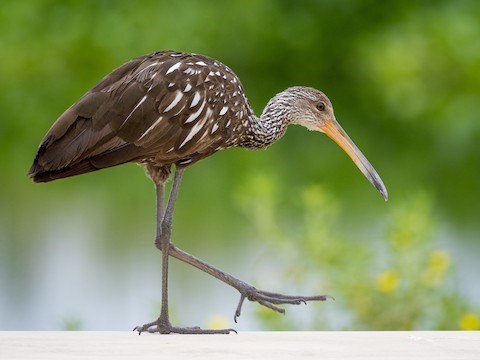Birdfinding.info ⇒ The northern form of the Limpkin is common, widespread, and increasing in various types of wetlands in Florida, Cuba, Puerto Rico, eastern Mexico, and Central America. Uncommon and local in western Mexico, the northern Bahamas, Jamaica, and Hispaniola. Increasingly regular on the coastal plain of southeastern Texas and southern Louisiana.
“Speckled Limpkin”
Aramus guarauna pictus
Humid lowlands from the southeastern U.S. to Panama.
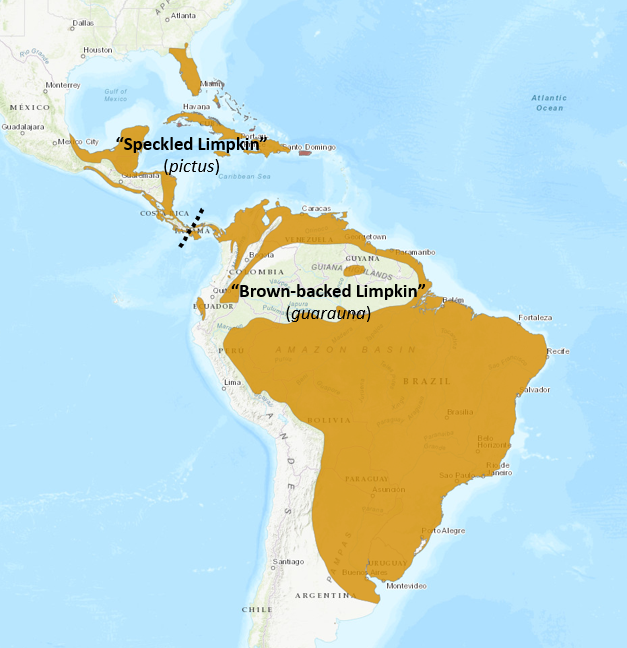
Approximate distribution of the Limpkin, both “Speckled” and “Brown-backed” forms. © BirdLife International 2016
The “Speckled Limpkin” is resident in the southeastern U.S. from southeastern Texas to Florida, the northern and central Bahamas, Cuba, the Isle of Youth, Jamaica, Hispaniola, Puerto Rico, and the mainland of Middle America. On the Pacific slope it occurs from Nayarit to Chiriquí; on the Caribbean slope from northern Veracruz to Bocas del Toro; and locally or sporadically in interior valleys from Jalisco to Costa Rica.
Since the early 2000s, its range has expanded dramatically to the north and west, as its U.S. range was traditionally limited to Florida and southernmost Georgia, and its range along Mexico’s Pacific coast traditionally ended around the Isthmus of Tehuantepec. At the same time, it has less dramatically extended its range southward in the Pacific lowlands to southern Costa Rica and into Panama (where it seems likely to overlap with the “Brown-backed Limpkin” at some point in the 2020s).
In conjunction with its range expansion, dispersing wanderers have been found increasingly often and farther north and west—a trend that seems likely to continue. As of 2022, it has been recorded northwest to northern Sinaloa and nearly throughout the eastern U.S.: on the Great Plains north to Nebraska; in the Great Lakes north to Minnesota, Wisconsin, Michigan, and western New York; and on the Atlantic Seaboard north to Maryland.
Identification
Distinctive: a medium-large, long-necked, long-legged, brown, ibis-like wetland bird with a habitually hunched posture.
Similar to its South American counterpart, the “Brown-backed Limpkin” (potential overlap mainly limited to Panama), but otherwise unlikely to be confused. The two forms are readily differentiated by the extent of streaking on the head, neck, body, and wings.
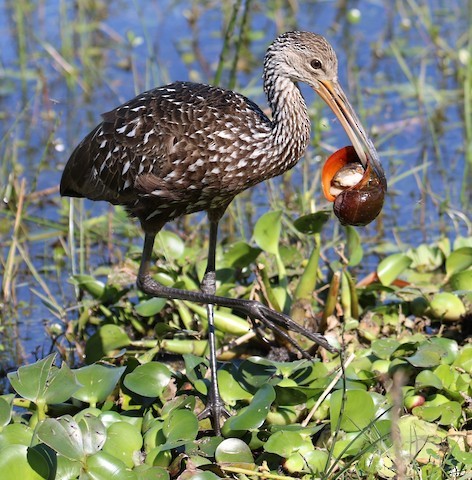
“Speckled Limpkin”, A. g. pictus, holding a Pomacea snail. (Joe Overstreet Road, Osceola County, Florida; January 26, 2020.) © Barbara Strobino
The bill is long, fairly thick, and slightly decurved, usually orangish or yellowish toward the base and blackish toward the tip.

“Speckled Limpkin”, A. g. pictus, juvenile following adult holding a Pomacea snail—note the juvenile’s short bill. (Kissimmee, Florida; May 20, 2022.) © Cesar Ponce
The head and neck are heavily streaked, primarily whitish with brown streaks.
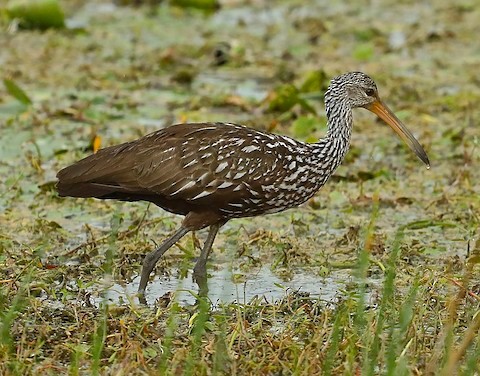
“Speckled Limpkin”, A. g. pictus, showing exceptionally dense white streaking. (Winding Waters Natural Area, West Palm Beach, Florida; November 2, 2018.) © Charles Lyon
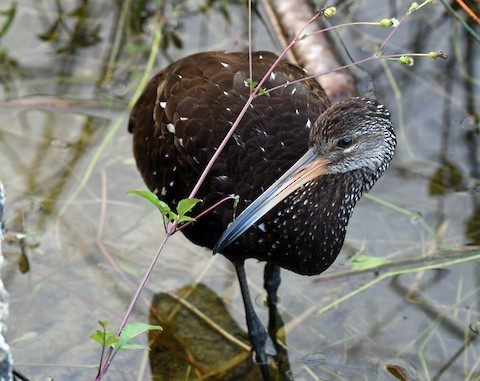
“Speckled Limpkin”, A. g. dolosus, showing only sparse white streaking on the upperparts. (Laguna Cobá, Tulum, Quintana Roo, Mexico; December 9, 2017.) © Charles Hundertmark
The body plumage is brown overall and heavily streaked with bold white arrowheads on the breast, back, and wings.
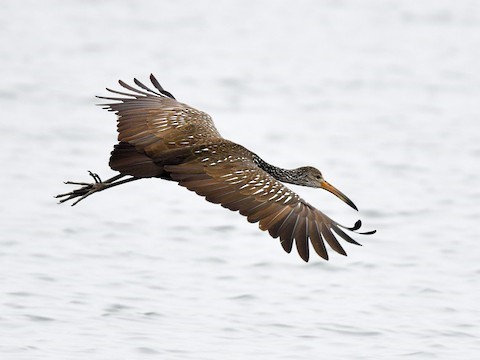
“Speckled Limpkin”, A. g. pictus, dorsal view showing white streaks on the upperwing coverts. (Heritage Park, Olathe, Kansas; November 15, 2022.) © George Chiu

“Speckled Limpkin”, A. g. pictus, dorsal view showing white streaks on the underwing coverts. (Heritage Park, Olathe, Kansas; November 15, 2022.) © George Chiu
When seen in flight, the wings are mostly brown with white streaking on the coverts—both uppersides and undersides.
Notes
Polytypic form consisting of three recognized subspecies (pictus, elucus, and dolosus), collectively one of two distinct forms of the Limpkin.
More Images of the “Speckled Limpkin”

“Speckled Limpkin”, A. g. pictus. (Walking Trail Woodland, Ottawa National Wildlife Refuge, Ohio; December 12, 2019.) © Brad Imhoff

“Speckled Limpkin”, A. g. pictus. (Walking Trail Woodland, Ottawa National Wildlife Refuge, Ohio; December 12, 2019.) © Brad Imhoff
References
Alderfer, J., and J.L. Dunn. 2014. National Geographic Complete Birds of North America (Second Edition). National Geographic Society, Washington, D.C.
BirdLife International. 2016. Aramus guarauna. The IUCN Red List of Threatened Species 2016: e.T22692174A93339530. https://dx.doi.org/10.2305/IUCN.UK.2016-3.RLTS.T22692174A93339530.en. (Accessed December 18, 2022.)
eBird. 2022. eBird: An online database of bird distribution and abundance. Cornell Lab of Ornithology, Ithaca, N.Y. http://www.ebird.org. (Accessed December 18, 2022.)
Fagan, J., and O. Komar. 2016. Peterson Field Guide to the Birds of Northern Central America. Houghton Mifflin Harcourt, New York.
Garrigues, R., and R. Dean. 2014. The Birds of Costa Rica: A Field Guide (Second Edition). Cornell University Press.
Howell, S.N.G., and S. Webb. 1995. A Guide to the Birds of Mexico and Northern Central America. Oxford University Press.
Kirwan, G.M., A. Levesque, M. Oberle, and C.J. Sharpe. 2019. Birds of the West Indies. Lynx Edicions, Barcelona.
Latta, S., C. Rimmer, A. Keith, J. Wiley, H. Raffaele, K. McFarland, and E. Fernandez. 2006. Birds of the Dominican Republic and Haiti. Princeton University Press.
Raffaele, H., J. Wiley, O. Garrido, A. Keith, and J. Raffaele. 1998. A Guide to the Birds of the West Indies. Princeton University Press.
Ridgely, R.S., and J.A. Gwynne. 1989. A Guide to the Birds of Panama (Second Edition). Princeton University Press.
Sibley, D.A. 2014. The Sibley Guide to Birds (Second Edition). Alfred A. Knopf. New York.
Xeno-Canto. 2022. Limpkin – Aramus guarauna. https://xeno-canto.org/species/Aramus-guarauna. (Accessed December 18, 2022.)
